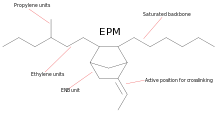Ethylene propylene rubber
Ethylene propylene rubber (EPR, sometimes called EPM, the E refers to ethylene, P to propylene and M refers to its classification in ASTM standard D-1418 since the M class includes rubbers having a saturated chain of the polymethylene type)[1] is a type of synthetic elastomer that is closely related to EPDM rubber (EPM is a copolymer of ethylene and propylene whereas EPDM rubber is a terpolymer of ethylene, propylene and a diene-component). Since it began to be produced in the 1960s, production has increased to 870 metric tons per annum, mostly due to advances in polymerization and catalyst technologies which allow polymers to be designed for specific purposes.[2][3]

Properties
EPM is considered a valuable elastomer due to its useful chemical and physical properties; it is resistant to heat, oxidation, ozone and the weather (owing to its stable, saturated backbone) and it is also not susceptible to color loss.[3] As a non-polar compound, EPM is an electrical resistor and it is insoluble in many polar solvents, both protic and aprotic. Amorphous forms of EPM are flexible at low temperatures (with glass transition points around -60 °C).[3] Via selection of certain sulfur compounds EPM can remain heat resistant up to 130 °C and up to 160 °C with peroxide curing. These two tables contain some of the main properties of EPM.[3]
Polymer Properties
| Property Type | EPM Property |
|---|---|
| Mooney viscosity at 125 °C | 5-200 |
| Ethylene content percentage by weight | 45-80 |
| Diene content percentage by weight | 0-15 |
| Specific gravity | 0.855-0.880 |
Vulcanizate Properties
| Property Type | EPM Property |
|---|---|
| Hardness (Shore A durometer) | 30-95 |
| Tensile strength, MPa | 7-21 |
| Elongation percentage | 100-600 |
| Compression set B percentage | 20-60 |
| Useful temperature range °C | -50 to +160 |
| Tear resistance | Fair to good |
| Abrasion resistance | Fair to good |
| Resilience | Fair to good |
| Electrical properties | Insulator |
Uses
EPM has a large number of uses due to the many ways in which the polymer can be designed, for example; it is used in automotive weather-stripping and seals, self-amalgamating tape, glass run channels, radiators, garden and appliance hoses, tubing, belts, roofing membranes, rubber mechanical goods, plastic impact modification, thermoplastic vulcanisates and motor oil additive applications. EPM is even more prevalent as an insulator for high-voltage cables since it has improved insulative characteristics over more traditional cables, such as cross-linked polyethylene, enabling a smaller cross sectional area for the same load carrying capacity. The cable is flexible and suited to applications where regular cable movement is required such as in the mining industry.[3][4]
Producers
Major producers and suppliers of EPM include Crompton Corporation, Exxon-Mobil, Dupont, Herdillia, Kumho Polychem, LANXESS, Mitsui Chemicals, Polimeri Europa and Sumitomo Chemical.[3]
Manufacture
EPM manufacture uses the same monomers as polyethene and polypropene, the ethylene and propylene monomers are randomly combined to yield a rubbery, stable polymer. By varying the monomer ratios and method by which the monomers are combined different forms of EPM can be formed (with a wide range of Mooney viscosities); ranging from amorphous to semi-crystalline. A third, non-conjugated diene monomer can be terpolymerized in a controlled manner to maintain a saturated backbone ready for vulcanization or polymer modification.[3]
References
- ↑ EPDM rubber Wikipedia EPDM rubber Friday 20 April 2012
- ↑ http://www.azom.com/article.aspx?ArticleID=1822 Azom.com, Ethylene Propylene Rubbers, Thursday 19 April 2012
- ↑ 3.0 3.1 3.2 3.3 3.4 3.5 3.6 http://www.iisrp.com/webpolymers/10epdmsep11.pdf iisrp, Ethylene-Propylene Rubbers & Elastomers, Thursday 19 April 2012
- ↑ http://www.azom.com/article.aspx?ArticleID=1822#_Typical_Areas_of Azom.com, Ethylene Propylene Rubbers: Typical Areas of Application, Thursday 19 April 2012